
|   |

|   |
Utsav's Unbound Beats of India - Dr. Sunil Kothari e-mail: sunilkothari1833@gmail.com Pics courtesy: Utsav April 25, 2013 Ranjana Gauhar's Utsav Educational and Cultural Society activities have included several welcome facets for the past twenty six years. Besides education, preservation, promotion and popularizing classical, traditional dances, in particular Odissi dance and music, Ranjana has endeavoured to offer a platform to young and promising exponents of classical dance to encourage them and bring their talent to the notice of wider community of rasikas. Besides the present festival under review, Ranjana has been presenting Sare Jahan Se Achha festival on 15th August highlighting in various dance forms, the glory of India. In Kalinga Utsav, she presents traditional Odiya dancers, including Gotipua dancers and also organizes seminar on Odissi dance and music. 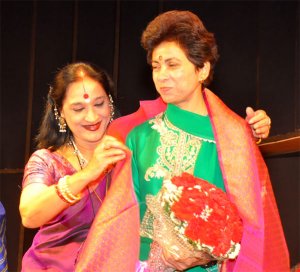 Ranjana Gauhar & Kumari Selja
The opening Odissi presentation was by German dancer Gudrun Martins trained by Sangeeta Das, a disciple of Durgacharan Ranbir. Gurdrun has an arresting stage presence. Tall, well built and with a fine figure, her movements were neat and perfect. That she is a foreigner never bothered the audience. Inspired by the sun god at Konark temple, Gudrun presented Suryashtakam as taught to her by Sangeeta Das whose guru Durgacharan Ranbir has interwoven arresting images in the choreography. The effulgent glory of the sun, its all pervading light, known as Adi Deva, one riding with seven horses in a chariot Saptashva, one who has triguna, the three qualities reminding devotees of Brahma, Vishnu and Maheshwara, one who removes sins, whose sahasra jihvas, thousand tongues (rays) illuminate the universe, to that Surya devata, the devotee says: Pranamami aham devam namostubhyam. Gurdun held poses with balance, took in a trice yogic postures, bent backwards, letting her head touch the raised foot, took yogasana pose with both hands touching the ground, danced with pirouettes in exact tala and created a favourable impression. All dancers performed to recorded music, but the intensity with which Gurdun performed one never felt that the music was recorded. I understand that she runs her own institution in Germany and regularly visits India to study further. She did her guru proud. 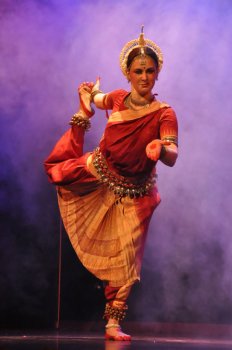 Gudrun Martins 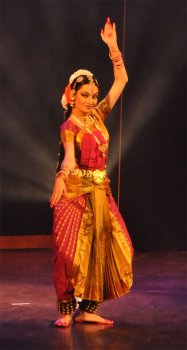 Suhasini Dhanki The surprise of the evening was Suhasini Dhanki, a young disciple of Dr Sandhya Purecha, who gave a delectable exposition of Bharatanatyam, for which her guru had chosen the Varnam 'Danike' of the Tanjore Quartette Sivananda's composition. Even though she performed it within a time span of twenty minutes, Suhasini left an indelible impression of her excellent training displaying her command over the Tanjore style, using of late rarely seen adavus, and nritta, reflecting the storehouse of valuable legacy Acharya Parvati Kumar has left behind. Young, attractive, personable and with eyes registering expressions effortlessly, Suhasini danced the sanchari for Mahadeva, who protected Markendeya, when Yama used Yamapasha, noose, and Lord Shiva sent Yama back. When an elephant was let loose, Lord Shiva killed him and adorned himself with the hide. The event is immortalized in Krittivasa sculpture. As a nayika, Suhasini created a favourable impression, winning rounds of applause for her impeccable Bharatanatyam. Kudos to Dr. Sandhya Purecha for training her so well. 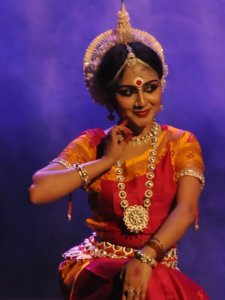 Sanchita Banerjee
From Kiev, Ukraine, Jayalakshmi Eswar's disciple Ganna Smirnova, who I saw in February at Ahmedabad, once again proved that with determination and hard work, she with her Kalakshetra bani, far away in Kiev, carries on practice without losing contact with India, visiting regularly and refreshing her technique with her guru. In Devi Mangalam, she paid obeisance to Adi Shakti, Saraswati and Mahalakshmi. The images of Mahakali were impressive whereas for Lakshmi as Mukundapriya born out of ksheersaagara mathanam (churning of the ocean), she enacted those sequences competently. Her tillana in Bhupalam raga based on Swati Tirunal's composition was scintillating with covering of the stage in periya adavu and ending it with reposeful mood. She has imbibed such qualities of an Indian devotee that she hardly looks one from Ukraine! She showed very high standard of technique. Namrata Pamnani trained at Kathak Kendra under Bharati Gupta and other gurus began well with composition in praise of Lord Shiva and gave ample proof of her taiyyari in Kathak. However while performing Tarana in raag Marwa, her ghunghroos got loosened. She went twice back stage and continued performing, but evidently she had lost confidence and begged of the audience to forgive her as she could not dance. The audience having witnessed former four dancers with high standard assured her of their appreciation. All the four dancers and in part Namrata on the opening day proved that they were ready and waiting in the wings to take over from the senior dancers with confidence and excellent training. At the end of felicitation to the dancers, the audience crowded around the young performers and praised them for their high standard. On the second day, D Suresh Goel, Director General of Indian Council for Cultural relations, inaugurated the show, lighting the lamp. From Bhubaneswar, Pushpita Mishra, a disciple of Guru Pankaj Charan Das and later on trained by other gurus in Odisha, began with prayer in praise of Lord Vinayaka and described the attributes of Ganapati, with his pot belly, lambodara, Buddhi pradayaka, giver of intelligence, destroyer of evil and so on, evoking iconic images of Ganesha. In next number as taught to her by Natvar Maharana, she dwelt upon the goddesses Durga, Kali, Lakshmi and Sarswati to the music composed by Sharad Sahoo. She succeeded in evoking the images of Durga and Kali with their ferocious mood, but in few passages she found it difficult to negotiate her movements and looked unsteady. She would do well to rehearse her numbers carefully and avoid a feeling of being unsteady in her poses. 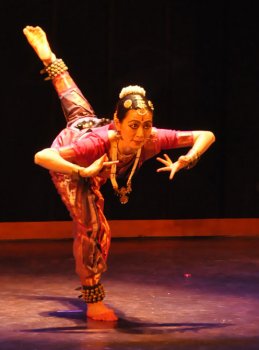 Hiroko Fujiwara
Daughter of Kuchipudi exponent Rashmi Vaidyalingam, a disciple of Raja and Radha Reddy, Shloka Vaidyalingam has received rigorous training in Kuchipudi under the two gurus and her mother, and it showed. She evidently has confidence and verve. The typical Raja Radha Reddy style has been well imbibed by her. She performed Dashavatra in Mohanam and in tishra triputa tala, with usual speed and force. The depiction of avatars differs from the well known Gita Govinda dashavatara. For instance, for depicting Balarama wielding a plough, the incident in Kuchipudi Dashavatara sabdam is of Balarama killing Kamsa, whereas in Gita Govinda, the story dwells upon Yamuna river being subjugated by Balarama. Similarly in depiction of Buddhavatara, he is not being distracted by the beautiful damsels who try to seduce him. It is shown suggestively in the presentation. Kalki avatara had interesting ashva gati, the speed of horse, on which Kalki is shown astride. She concluded Dashavatara with sholka from Gita, Yada yada hi dharmasya glanir bhavati Bharat, Krishna telling Arjuna, that whenever there is Dharma waning, he takes incarnation to protect the universe. She ended with pose of Sheshasayi, Vishnu reclining on serpent Shesha. Shloka has a vibrant stage presence. She dances with understanding of the sahitya and it seems she has internalized its meaning, which was well projected. The only male dancer was Sanjib Bhattacharya in Manipuri. A disciple of Guru Bipin Singh and Darshana Jhaveri, he has mastered the Manipuri technique as taught by Guru Bipin Singh. He projects his style faithfully. The tandava, vigorous dance suited to male dancers was well choreographed by Guru Bipin Singh. Sanjib's bhramaris, pirouettes were as they should be in Manipuri. In Banddha Mandlai Nartan, which Guru Bipin Singh had choreographed in his last years and taught to Sanjib had complex tala structure. Guru ji had used teen tala macha and Dahskosha tala. In a solo format it gave scope to Sanjib to display his virtuosity. From Gopa Ras, Sanjib presented game of ball between Balarama and Krishna to the song 'Khelat Rama Kanhai.' The quick movements of throwing ball and catching it were executed with precision. Guru Bipin Singh had, from Sankirtan and Rasalila, drawn inspiration to create Telana using mnemonic syllables 'Tom derena' and woven them into a pure dance number similar to Tarana. The use of Tanchap and Rajmel talas, at times Sanjib reciting the bols, was ingenious and showed the complexity of its choreography. Sanjib performed it competently. His costume for male dancer mostly as Krishna was colourful. What he needs to be careful about is to keep his lips closed, so that the face does not show strain. He deserves all the credit for carrying on Guru Bipin Singh's legacy. 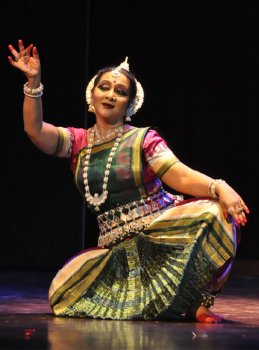 Jyoti Srivastav
In abhinaya to ashtapadi Ratisukhasare, sakhi pleads to Radha to go and meet Krishna who is waiting for her in his bower. Na kuru nitambini gamana vilambana, do not delay going unto him, anusratamhridayesham, follow your beloved, stanzas were full of sakhi's concern for Radha and were well projected. Sakhi's advice to Radha that when she listens to his divine flute and his invitation to be with him in love play, she need not delay, enacted to the notes of flute was imaginatively danced. The hastas for ratikrida, love play, has a poetic and suggestive touch in Odissi. Jyoti is a seasoned dancer and with easy felicity registers expression in a delectable manner. The two day festival ended on a joyous note. What distracted watching these performances was the indiscriminate use of smoke let loose with a hissing sound. It did not always help create an aesthetic appeal. As photographer Avinash Pasricha commented humorously, one felt that the performance turned into a smoke! What a rasika enjoyed evaporated with this gimmick of creating smoke clouds with ill conceived light effects. On the positive side was the fact that young, gifted, focused four dancers were given a platform which should help them carry forward their career. Ranjana Gauhar's intent to organize this festival from year to year is a most welcome step on part of a senior dancer who cares for the future of classical dance.  Dr. Sunil Kothari is a dance historian, scholar, author and a renowned dance critic. He is Vice President of World Dance Alliance Asia Pacific India chapter, based in New Delhi. He is honored by the President of India with Padma Shri, Sangeet Natak Akademi award and Senior Critic Award from Dance Critics Association, NYC. He is a regular contributor to www.narthaki.com, the roving critic for monthly magazine Sruti and is a contributing editor of Nartanam for the past 12 years. Post your comments Pl provide your name and email id along with your comment. All appropriate comments posted with name and email id in the blog will also be featured in the site. |